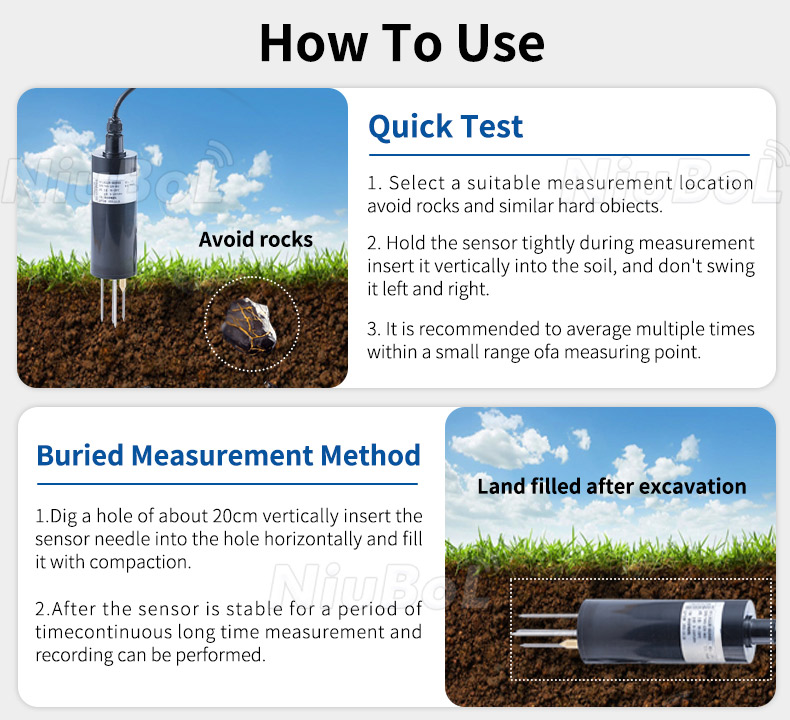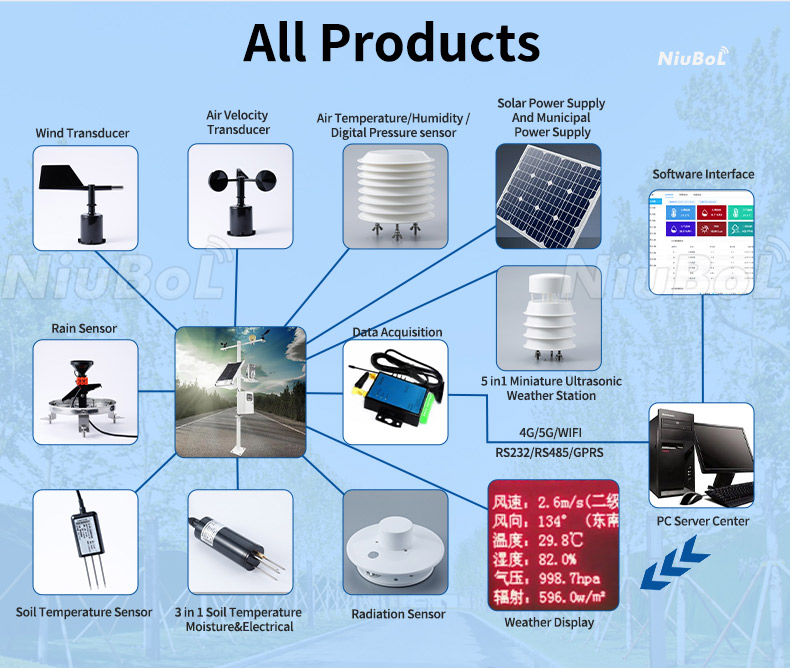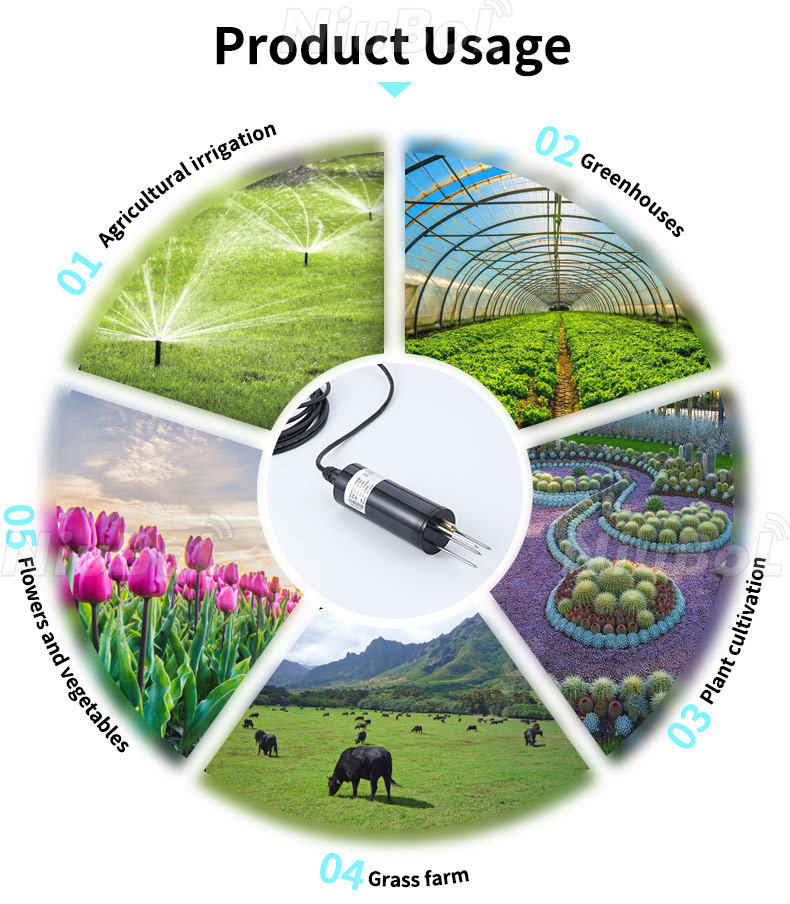

— Blogs —
—Products—
 Consumer hotline +8618073152920
Consumer hotline +8618073152920 WhatsApp:+8615367865107
Address:Room 102, District D, Houhu Industrial Park, Yuelu District, Changsha City, Hunan Province, China
Product knowledge
Time:2024-07-07 17:44:39 Popularity:625
INTRODUCTION: Irrigation moisture sensor is an agrotechnical device that is used to monitor the soil moisture condition in order to help farmers manage irrigation in a rational way. The application of such sensors is important for improving agricultural water utilization efficiency, promoting crop growth and protecting the environment. In this paper, we will introduce the basic concept of irrigation humidity sensor, its working principle and its role value in agricultural production.
1, Definition of irrigation moisture sensor
Irrigation moisture sensor is a device used to measure soil moisture, which detects the moisture content in the soil and compares it with a preset threshold. Based on the actual soil moisture, the sensor can provide data feedback to farmers to help them decide when they need to irrigate and how much to irrigate.
2、Soil Moisture Sensor Type.
- Tensiometer:Measures soil water tension, indicating how tightly water is held in the soil.
- Capacitance Sensor:Determines soil moisture by measuring changes in capacitance.
- Time Domain Reflectance (TDR) Sensors:Evaluate soil moisture content by measuring the time it takes for an electromagnetic pulse to pass through the soil.
- FDR soil moisture sensor:Determine soil moisture content by measuring the dielectric constant in the soil.
3、Working Principle of Irrigation Moisture Sensor
Soil moisture sensors play an important role in agriculture, water resource management and environmental monitoring, among which FDR (Frequency Domain Reflectometry, Frequency Domain Reflectometry) and TDR (Time Domain Reflectometry, Time Domain Reflectometry) are two common sensor technologies. Following is the working principle of these two sensors:
3.1 Working Principle of FDR Soil Moisture Sensor
The FDR soil moisture sensor determines the soil moisture content by measuring the dielectric constant in the soil.The FDR technique utilizes the principle of reflection of high frequency electromagnetic waves in media with different dielectric constants. The specific working process is as follows:
1. Signal Transmission and Reception: The sensor introduces the high frequency signal into the soil through the probe. When the signal meets the interface of the medium will be reflected, the sensor then receive the reflected signal.
2. Signal analysis: By calculating the time delay and amplitude of the reflected signal, the distance and dielectric constant of the reflection point are determined. The dielectric constant of soil changes with its water content, when the water content in the soil increases, its dielectric constant will also increase.
3. Data processing: The instrument receives the signals measured by the probe and carries out data processing and output, so as to get the water content information of the soil.
With the advantages of high measurement accuracy, wide application range and strong anti-interference performance, FDR sensor has been widely used in agriculture, water resource management and environmental monitoring.
3.2 Working principle of TDR soil moisture sensor
The TDR soil moisture sensor measures the soil moisture content by measuring the propagation time of the electrical energy reflected wave along the transmission line. The specific process is as follows:
1. Signal Transmission: The TDR sensor transmits an electromagnetic pulse signal into the soil.
2. Signal propagation and reflection: When this signal propagates in the soil, it is reflected and scattered when it encounters different media interfaces (e.g. soil particles, moisture, etc.).
3. Signal reception and processing: The sensor receives the reflected signal and measures the time of signal propagation. This time is related to the charge storage capacity (i.e. volumetric water content) of the soil.
4. Data analysis: Through a specific algorithm and calibration process, the signal propagation time is converted into soil water content.
The TDR sensor has the advantages of continuous readings, insensitivity to salinity, and high accuracy. However, it is more complex to use than capacitive sensors, and it is also more costly and consumes more power.
In summary, FDR and TDR soil moisture sensors are different in measurement principle, but both can effectively measure soil moisture content and provide important data support for agricultural production and environmental monitoring. In practical applications, you can choose the appropriate sensor type and model according to the specific needs and scenarios.

4, irrigation moisture sensor is how to work
Irrigation moisture sensor is usually connected to the data acquisition system, the measurement results will be transmitted to the agricultural management system, so that farmers can make irrigation decisions. Here's how it works:
-Irrigation moisture sensors are buried at different depths in the crop root zone.
- Data Acquisition:The sensors measure soil moisture periodically or continuously. The data is transmitted to the irrigation controller or centralized system.
- Data analysis:The information is processed to determine the need for irrigation based on preset thresholds or crop-specific needs.
-Automation:Integrated with the irrigation system, the sensor can trigger automatic watering cycles based on real-time moisture data.

5, irrigation humidity sensor role value
1. Save water: By accurately monitoring soil moisture, irrigation moisture sensors can help farmers avoid excessive or unnecessary irrigation, thus saving water.
2. Improve crop yield: reasonable water management helps crop growth, irrigation moisture sensor can help farmers according to the actual needs of the soil irrigation, improve crop yield.
3. Reduce environmental pollution: Irrational irrigation can lead to water pollution and soil salinization. The use of irrigation humidity sensors can reduce this pollution and protect the environment.
4. Improve agricultural productivity: The data provided by the sensor can help farmers better manage their farmland and improve agricultural productivity.
6. There are several key factors to consider when choosing the right irrigation moisture sensor for your farm:
1. soil type: different soil types (e.g. sandy, clay, loam) have different water retention capacities, so you need to choose sensors that can be adapted to your farm's specific soil type.
2. Crop Needs: Different crops require different amounts of water and the sensor should be able to meet the needs of the crops grown on your farm.
3. Irrigation system: The type of irrigation system used on your farm (e.g. drip, sprinkler, flood, etc.) will affect how the sensors will be installed and how intensively they will be deployed.
4. Environmental conditions: The climatic conditions of your farm (e.g. temperature, humidity, salinity, etc.) may affect the performance and lifetime of the sensor.
5. Budget: The price of the sensor and the cost of maintenance are also factors to consider when making a selection.
6. data transmission and processing: choose sensors that are compatible with your existing farm management system (e.g., wired or wireless communication capabilities, data storage and analysis functions).
7. Reliability and maintenance: Select sensors with high durability and easy maintenance to minimize failures and maintenance costs over the long term.
8. Vendor support and after-sales service: choose a reputable vendor that provides good technical support and after-sales service.

Irrigation moisture sensors are an important tool in modern agriculture, contributing to precise irrigation management, water conservation, crop productivity and minimizing environmental impact. By accurately monitoring soil moisture levels and automating the irrigation process, these sensors enable farmers to make informed decisions, optimize water resources, and contribute to sustainable agricultural practices worldwide.
Before selecting a sensor, you may want to speak with an agricultural technologist or salesperson to ensure that the sensor you choose will meet your specific needs.
1.NBL-S-THR Soil Temperature Moisture Sensor datasheet
NBL-S-THR-Soil-temperature-and-moisture-sensors-Instruction-Manual-V4.0.pdf
2. NBL-S-TMC Soil Temperature Moisture EC Sensor datasheet
NBL-S-TMC-Soil-temperature-and-moisture-conductivity-sensor.pdf
3. NBL-S-TM Soil Temperature Moisture Sensor datasheet
NBL-S-TM-Soil-temperature-and-moisture-sensor-Instruction-Manual-4.0.pdf
4. NBL-S-TMCS Soil Temperature, Moisture, Conductivity and Salinity Integrated Sensor
NBL-S-TMCS-Soil-Temperature-Humidity-Conductivity-and-Salinity-Sensor.pdf
5. NBL-S-TMCS-7 Soil Temperature, Moisture, NPK, Conductivity and pH Integrated Sensor
7-in-1-Soil-Composite-Sensor-Manual.pdf
4. NBL-S-TMCS-8 Soil Temperature, Moisture, NPK, pH, Conductivity and Salinity Integrated Sensor
Related recommendations
Sensors & Weather Stations Catalog
Agriculture Sensors and Weather Stations Catalog-NiuBoL.pdf
Weather Stations Catalog-NiuBoL.pdf
Related products
 Combined air temperature and relative humidity sensor
Combined air temperature and relative humidity sensor Soil Moisture Temperature sensor for irrigation
Soil Moisture Temperature sensor for irrigation Soil pH sensor RS485 soil Testing instrument soil ph meter for agriculture
Soil pH sensor RS485 soil Testing instrument soil ph meter for agriculture Wind Speed sensor Output Modbus/RS485/Analog/0-5V/4-20mA
Wind Speed sensor Output Modbus/RS485/Analog/0-5V/4-20mA Tipping bucket rain gauge for weather monitoring auto rainfall sensor RS485/Outdoor/stainless steel
Tipping bucket rain gauge for weather monitoring auto rainfall sensor RS485/Outdoor/stainless steel Pyranometer Solar Radiation Sensor 4-20mA/RS485
Pyranometer Solar Radiation Sensor 4-20mA/RS485
Screenshot, WhatsApp to identify the QR code
WhatsApp number:+8615367865107
(Click on WhatsApp to copy and add friends)